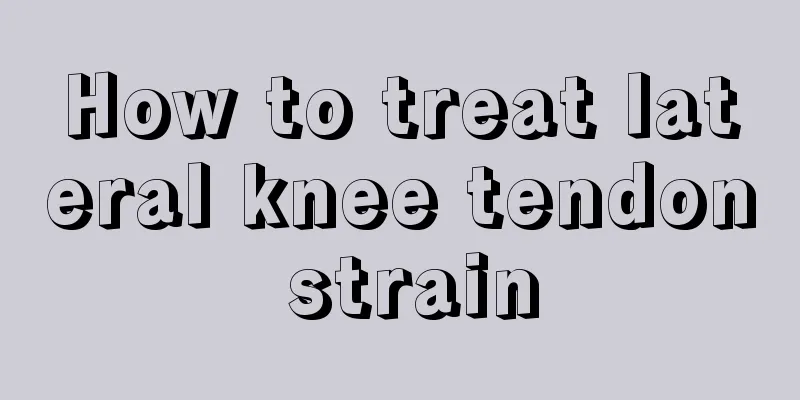How to treat lateral knee tendon strain

|
The treatment of lateral knee tendon strain includes non-surgical and surgical treatments. For non-surgical treatment, patients are advised to seal the local area, apply pressure with a bandage, and fix it with plaster if necessary. 1. Non-surgical treatment? Suitable for patients with simple knee LCL injury with relatively minor injuries. Take a stress photograph of the knee adducted. If the joint gap is dilated by 0.4cm, an elastic bandage can be used for pressure bandage. If the joint gap is dilated by 0.5-1.2cm, drain the blood from the knee joint and apply a pressure bandage. Bend the knee 20°-30° and fix the long leg with anterior-posterior plaster. Remove the plaster after 6 weeks and start practicing knee joint activities. During the period of plaster fixation, quadriceps contraction training should be strengthened 2. Surgical treatment? In the past, it was believed that complete rupture of the LCL of the knee did not need to be repaired. However, recent observations have shown that some patients who did not undergo repair had significant sequelae, often leading to anterolateral rotational instability of the knee joint. This is even more obvious if combined with ACL injury. When combined with PCL injury, posterolateral rotational instability occurs, and the lateral tibial condyle rotates backward and subluxates. Therefore, in recent years, once severe lateral collateral ligament rupture is diagnosed, it is decided to undergo surgical repair. 3. Fresh knee LCL injury: For patients with avulsion of the fibular head fracture at the knee LCL insertion point, a straight incision 2-3 cm above and below the fibular head is used. Keep the fracture fragment in contact with the lateral collateral ligament of the knee, reposition the displaced avulsed fracture fragment, and fix the fracture fragment in place with a screw. For simple rupture of the LCL in the middle of the knee, a 4-5 cm long straight incision is made on the outside of the knee. The two ends of the LCL are carefully separated to find out. The knee is bent to 30°, the two ends are tightened and sutured end to end. If the lateral collateral ligament of the knee is loose, overlapping sutures can be done. 4. Old knee LCL injury: ① For patients with unstable knee joint caused by loose knee LCL, knee LCL tightening should be performed. Augustine method: A straight incision or S-shaped incision 5-6 cm long is made on the outside of the knee. The cortical bone at the starting point of the lateral femoral condyle of the knee LCL is chiseled off (1.5 cm × 1.5 cm in size), displaced 1-2 cm upward (proximally) and tightened. A corresponding small piece of cortical bone is cut off with a bone chisel to make it rough, and then a screw is used to screw the cortical bone at the starting point of the ligament into place for fixation. In addition to the above method, the lateral head of the gastrocnemius muscle can be cut off from the starting point and moved forward, and sutured to the starting point of the displaced knee LCL to strengthen the ligament. ② For posterolateral rotational instability caused by LCL rupture and cruciate ligament injury, the Augustine method and iliotibial band transfer can be performed. Cut off most of the iliotibial band insertion point at the lateral tibial condyle and free it 3 cm proximally. Move the cut end of the iliotibial band to the fibular head, tighten it, and fix it with silk suture. |
<<: What is the treatment for calculous cholecystitis
>>: How to effectively treat mouth ulcers
Recommend
What are the differences between C6 laser freckle removal and traditional laser freckle removal?
C6 laser freckle removal is a new freckle removal...
Seven major hazards of infusion to the human body
China's overtreatment, including the misuse o...
Only 20 years old and there is a sound when I turn my neck
It is a very common phenomenon that the neck make...
Will perianal abscess surgery be painful?
The occurrence of perianal abscess causes a lot o...
What are the advantages and disadvantages of microwave ovens
Microwave ovens have been widely used in daily li...
What are the common symptoms of fibroids?
Fibroid is one of the more common benign tumors. ...
Clinical manifestations of venous spasm
Nowadays, many young people are under great press...
What to wear when traveling in Yunnan
Nowadays, more and more people go out to travel t...
What to use to remove oil from face
People often tell you that you have an greasy fac...
What to do if dandruff can’t be washed off
I believe that many people have discovered why we...
How to remove grease stains in the kitchen
Recently, there have been continuous reports at n...
What to do if the stomach is hard when pressing on ovarian cancer
What should I do if my stomach feels hard when I ...
CT staging standards for esophageal cancer
It is unscientific to say that you can only know ...
Is gastric bleeding and bloody stool serious?
Bloody stools caused by gastric bleeding can be s...
Treatment of knee ligament sprain
Knee ligament sprain should be taken seriously. I...









